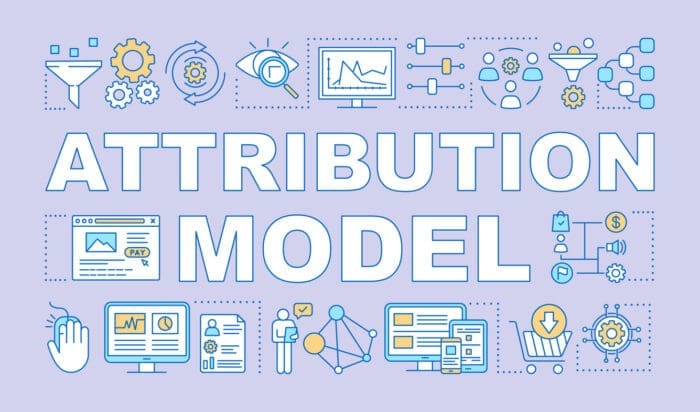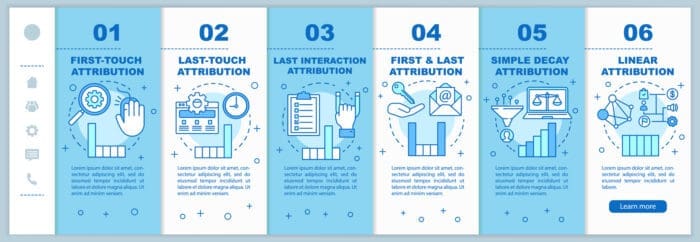Marketing attribution tracks which marketing channels drive conversions. It helps you measure the impact of each touchpoint in a customer’s journey. You can make informed decisions to improve your strategies and ROI using marketing attribution. This article will cover models, tools, and best practices.
Key Takeaways
- Marketing attribution measures the influence of various channels on crucial business metrics, aiding marketers in optimizing their strategies and budget allocation.
- Choosing the right attribution model is crucial. Single-touch models offer simplicity, while multi-touch models provide a more comprehensive view of the customer journey.
- Integrating AI enhances marketing attribution by accurately identifying successful touchpoints, enabling informed decisions and resource allocation for improved ROI.
Understanding Marketing Attribution

Marketing attribution is the process of measuring the impact of different marketing channels. It focuses on key business metrics like meetings, pipeline, and revenue. Marketers need to grasp digital marketing attribution to understand the impact and effectiveness of their marketing efforts. Attribution reports track the success of these efforts, revealing which channels or touchpoints contribute most to desired outcomes.
The complexity of modern customer journeys necessitates a comprehensive approach to attribution. By mapping out all marketing touchpoints that influence a purchase decision, marketers gain valuable insights into the interactions that lead to conversions. This understanding helps identify the top marketing channels driving conversions and provides a detailed overview of each customer journey, from initial contact to purchase.
Marketing attribution helps marketers understand the interactions that lead to a conversion point and identify the top marketing channels that drive conversions. Analyzing these insights allows businesses to focus on the channels and touchpoints that yield the highest returns, optimizing their marketing strategies.
Why is Marketing Attribution Important?

Understanding why marketing attribution is necessary begins with recognizing its role in analyzing the impact of marketing strategies throughout the customer journey. Attribution provides data that justifies marketing expenses, revealing the effectiveness of different marketing initiatives. This data-driven approach helps brands optimize their marketing budget by identifying the most effective channels and strategies.
Compelling marketing attribution enhances ROI by identifying the touchpoints that lead to conversions. A comprehensive view of marketing performance enables businesses to make strategic adjustments for improved efficiency. Understanding touchpoint effectiveness allows companies to refine their remarketing efforts and improve audience relevance.
Attribution processes can automate evaluations, providing relevant and accurate metrics for future marketing decisions. This automation saves time and ensures that marketing strategies are continually refined based on the latest data insights.
Types of Marketing Attribution Models
Marketing attribution models assign different credit to each interaction along the customer journey and can be divided into two main categories: single-touch and multi-touch models. Single-touch attribution models focus on a single interaction, such as the first or last touchpoint, while multi-touch attribution models distribute credit among several touchpoints.
Attribution models aim to determine campaign performance and understand how different touchpoints contribute to conversion. Selecting the right marketing attribution model helps businesses identify the most influential interactions and optimize their marketing efforts.
Single-Touch Attribution Models
Single-touch attribution models focus on a single interaction in the customer journey, assigning credit to one touchpoint. First-touch attribution gives full credit to the first interaction before a purchase, helping identify channels that generate initial interest. Conversely, last-touch attribution analyzes the final interaction before conversion and is commonly used for shorter sales cycles.
While single-touch attribution models provide clear insights into marketing performance, they have limitations. They can miss the entire consumer buying process and overlook multiple touchpoints influencing the customer journey.
Despite these limitations, they offer a straightforward approach to understanding marketing efforts' initial or final impact.
Multi-Touch Attribution Models
Multi-touch attribution models measure all interactions before a conversion, providing a more comprehensive customer journey overview. Linear attribution assigns equal credit to each interaction in the buyer journey, offering insights into overall marketing performance. Time decay attribution values touchpoints based on their proximity to the conversion event, giving more weight to recent interactions.
The U-shaped attribution model divides credit between the first and last touchpoints while rewarding significant touchpoints in between. The W-shaped attribution model gives equal credit to the first, last, and mid-funnel interaction, distributing the remaining credit among other touchpoints.
These multi-touch models provide richer insights than single-click attribution models, allowing marketers to make informed decisions.
Choosing the Right Attribution Model

Choosing an appropriate attribution model is crucial for accurately assessing the customer journey and optimizing marketing strategies effectively. Different brands have unique marketing strategies, making it essential to be selective when choosing an attribution model.
Factors such as sales cycle length, online vs. offline activities, and the complexity of the marketing strategy impact the choice of an attribution model. For instance, the time decay attribution model, which assigns more weight to interactions closer to the final purchase, is useful for long sales cycles. Position-based attribution models, which give significant credit to both the initial and final touchpoints, are suitable for complex sales processes.
Custom attribution models allow businesses to create tailored approaches reflecting their specific customer behavior and marketing strategies. Multi-touch attribution models may be more effective for addressing customer retention and gaining insights into all customer interactions leading to a conversion. Finalizing the attribution model choice should reflect the organization’s business needs and marketing complexities.
Implementing Marketing Attribution Tools
Marketing attribution tools like Google Analytics, Adjust, and Ruler Analytics offer valuable insights into customer interactions and marketing effectiveness. These tools feature features such as backend tracking, customizable reports, and multi-touch interaction analysis.
When selecting a marketing attribution tool, consider your business goals, key questions, and integration possibilities with existing systems. Platforms such as Google Analytics, Rockerbox, Dreamdata, and Windsor.ai offer unique functionalities, such as customer journey insights and extensive integrations, that enhance overall attribution effectiveness.
Best Practices for Effective Marketing Attribution

Aligning marketing and sales data throughout the sales funnel is a best practice for effective marketing attribution. Attribution reporting assists stakeholders by showing how marketing efforts impact business goals.
Defining clear marketing goals and integrating CRM systems with attribution tools enhances the effectiveness of attribution strategies by providing comprehensive insights into marketing impact.
Educate Your Stakeholders
Effectively communicating marketing attribution results requires identifying and providing the right stakeholders with useful data. Consistently sharing updated reports and valuable data helps support relationships with stakeholders in marketing attribution.
Managing stakeholders’ expectations, recognizing potential data inaccuracies, and using attribution analysis to clarify marketing strategy effectiveness are key to gaining stakeholder support.
Define Clear Goals
Setting clear marketing attribution goals helps evaluate campaign success and determine key performance indicators, which is essential for customizing attribution models to meet specific business needs. Identifying conversion sources or understanding content roles in the customer journey are key objectives in marketing attribution.
Defining conversion events helps clarify what constitutes a successful user journey.
Integrate CRM and Attribution Tools
Integrating CRM with attribution tools improves tracking and understanding of customer interactions over time. This integration provides comprehensive insights into marketing impact, improving both marketing and sales performance.
Combining CRM data with attribution analysis provides a holistic view of the customer journey, enabling more informed decisions.
Common Challenges in Marketing Attribution
The complexity of consumer journeys complicates tracking and measuring the effectiveness of all marketing channels. Different attribution models can yield varying results, causing confusion about which channel effectively drives conversions. Attribution models often struggle to account for the interdependencies among various marketing touchpoints.
The increasing focus on consumer privacy, such as the lack of third-party cookies and increased privacy regulations, exacerbates challenges in attribution. Using a hybrid approach that combines attribution with qualitative data and machine learning models can help adapt to privacy regulations.
Traditional attribution models can overlook crucial interactions, especially outside digital environments, neglecting offline interactions vital for understanding overall marketing effectiveness. Difficulties arise when tracking offline touchpoints, complicating the attribution of conversions.
The Role of AI in Modern Marketing Attribution
AI algorithms identify which actions and touchpoints lead to success, significantly enhancing ROI. Generative AI provides deeper insights, accurately attributing campaign success to actions and helping optimize strategies.
AI empowers marketers to measure impact and allocate resources efficiently, making it invaluable for modern marketing attribution.
How to Measure Marketing Attribution Effectively

Collecting marketing interaction data is the first step in creating trustworthy attribution reports. AI enhances measurement and attribution by linking consumer interactions with ads to online and offline behaviors. When deciding the time period for marketing attribution analysis, consider business type, seasonality, and sales cycle length.
A visual analytics dashboard helps identify patterns and clarify the average sales cycle timeline in marketing attribution. Different attribution models in platforms like HubSpot help analyze the buyer journey. After choosing an attribution model, the next step is to analyze the obtained data. Integration tools like HubSpot and Google Analytics help link information to specific contacts, improving attribution analysis.
Analyzing attribution data helps understand the value of interactions in relation to marketing efforts. Common challenges include combining offline and online data. Advanced tools help organizations without in-house data science capabilities implement effective attribution.
Using Attribution Data to Optimize Campaigns
Attribution model insights can enhance customer experience by pinpointing key interaction points within the buyer’s journey. Attribution reporting improves marketing efforts by enabling marketers to respond more effectively to customer needs. AI-generated audience insights enable more precise targeting and enhance personalization in marketing campaigns.
Machine learning algorithms suggest creative optimizations to improve marketing content engagement. AI integration allows marketers to make real-time adjustments to campaigns based on data analysis. AI uses predictive analytics based on past data to identify optimal times and locations for ad placements.
Understanding customer interactions helps align offerings to customer preferences, improving future product development.
Summary
In summary, mastering marketing attribution involves understanding its importance, choosing the right model, and implementing effective tools and best practices. Each offers unique insights into the customer journey from single-touch to multi-touch models. Businesses can enhance their attribution accuracy and optimize their marketing strategies by leveraging AI and integrating CRM systems.
By applying the insights gained from this guide, marketers can improve their campaign effectiveness, optimize their budget allocation, and ultimately drive better business outcomes. The journey of mastering marketing attribution is continuous, but the right approach can significantly improve marketing performance and ROI.

Frequently Asked Questions About Marketing Attribution
What is marketing attribution?
Marketing attribution measures how different marketing channels contribute to essential business outcomes like meetings, pipelines, and revenue. It enables organizations to understand the effectiveness of their marketing efforts.
Why is marketing attribution important?
Marketing attribution is essential as it allows businesses to evaluate the effectiveness of their marketing strategies across the customer journey, justify their marketing expenditures, and optimize budgets by identifying the most impactful channels.
What are the different types of marketing attribution models?
Marketing attribution models primarily fall into two categories: single-touch models, which attribute success to one interaction, and multi-touch models, which allocate credit across multiple interactions. Understanding these models is essential for accurately assessing the effectiveness of your marketing strategies.
How do AI and machine learning improve marketing attribution?
AI and machine learning enhance marketing attribution by precisely linking success to specific actions and touchpoints. This enables deeper insights and real-time adjustments to campaigns based on data analysis, leading to more effective marketing strategies.
What are the common challenges in marketing attribution?
Marketing attribution faces common challenges, such as the intricate nature of consumer journeys, adherence to privacy regulations, and the difficulties associated with tracking offline interactions. Addressing these issues is essential for accurate attribution and meaningful insights.

Ready to Master Marketing Attribution?
Discover how the right attribution model can transform your marketing strategy and boost ROI.
Contact Us: Schedule a Consultation
Explore tailored solutions for your business with our expert team.
Read More: Explore Our Insights
About the author
Mark A. Hope is the co-founder and Partner at Asymmetric Marketing, an innovative agency dedicated to creating high-performance sales and marketing systems, campaigns, processes, and strategies tailored for small businesses. With extensive experience spanning various industries, Asymmetric Marketing excels in delivering customized solutions that drive growth and success. If you’re looking to implement the strategies discussed in this article or need expert guidance on enhancing your marketing efforts, Mark is here to help. Contact him at 608-410-4450 or via email at mark.hope@asymmetric.pro.

